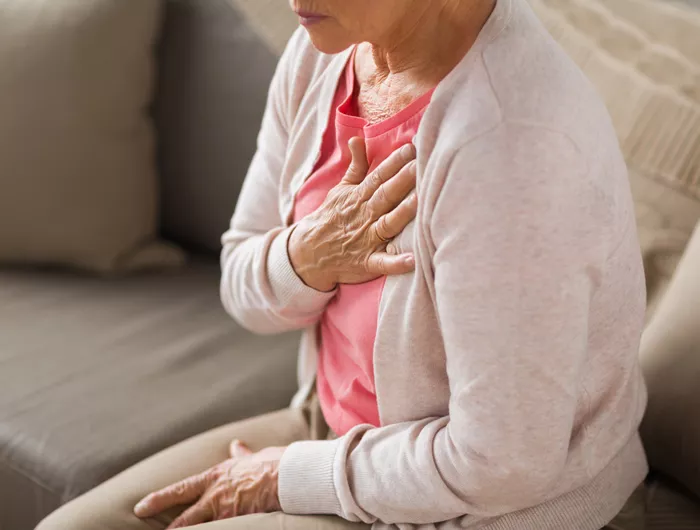Know the ABCs of chest pain

Syda Productions/stock.adobe.com.
Ever wonder if that chest pain you’re feeling could be a heart attack? You’re not alone.
“We have 6.5 million visits to the emergency department every year in the United States and 4 million office visits for a complaint of chest pain,” says Martha Gulati, president-elect of the American Society for Preventive Cardiology.
“It’s an incredibly common symptom. And chest pain can mean many different things, not just related to the heart.”
In fact, it’s usually not due to a heart attack.
“Only about 5 percent of the people that present to the emergency room with chest pain are having what we call an acute coronary syndrome,” says Gulati.
Among the other causes: “Chest pain can be due to things going on in your lungs, in your gastrointestinal system, in your chest wall,” she notes. “It can be as common as a musculoskeletal injury, like from lifting weights or a fracture, or it can even be from breast disease.”

Of course, doctors can’t treat chest pain lightly.
“If you are having some sort of acute cardiac event, it can be life threatening, so we don’t want to miss it,” says Gulati.
That’s why experts from the American Heart Association and the American College of Cardiology—led by Gulati—recently released guidelines to help doctors decide how to handle chest pain.
Here are some of the takeaways.
Critical questions
Among the questions doctors should consider when treating chest pain:
What type of pain?
Some kinds of chest pain are more likely to be due to a heart attack—that is, reduced blood flow to the heart muscle.
“Some people describe it as a tightness, squeezing, heaviness, or like an elephant on their chest,” says Gulati. The pain sometimes occurs after exercise or stress.
In contrast, pain that’s described as sharp, shifting, fleeting, tearing, or burning is less likely to signal that the heart muscle is starved of blood and oxygen (though no chest pain should be ignored).
The pain’s location also matters.
“It’s often described as central or on the left side of the chest, but sometimes it’s on the right side or even radiating to the back,” notes Gulati. People may also feel pain in the jaw, neck, shoulders, arms, or upper abdomen.
What patient?
Chest pain is the primary sign of a heart attack in both men and women. “The difference is that women usually report three or more additional symptoms,” such as shortness of breath, nausea, and fatigue, says Gulati.
Although men have a greater risk of heart disease, it—and cancer—are still the leading killers of women.
The difference in women’s symptoms may help explain why “they still have delays in getting timely and appropriate care,” says Gulati.
What test results?
When a patient arrives at the ER with chest pain, the first step is to take a medical history, do a physical exam, and get an electrocardiogram (EKG), which records electrical signals as the heart contracts.
The next step is a blood test to measure high-sensitivity cardiac troponin.
“It’s an incredibly accurate marker for damage to the heart muscle,” says Gulati, though some hospitals can’t yet test for the high-sensitivity version.
What risk?
Doctors use that data—and other factors like age, blood pressure, diabetes, LDL cholesterol, smoking, and weight—to size up a patient’s risk.
“If the patient has a high risk of having a heart attack, the decision is easy,” says Gulati. In some cases, doctors may do no tests at all.
“If we think this is likely to be a heart attack or heart attack waiting to happen, we would rush them to our cath lab,” explains Gulati. “We wouldn’t do an EKG or blood tests. We would do invasive coronary angiography.”
That is, they would use a thin tube (catheter) to inject a dye into blood vessels that feed the heart muscle—coronary arteries—to see if any are narrowed or blocked.
“We’d want to look at the coronary arteries right away, because lost time means lost heart muscle, and we’d potentially want to open up an artery to restore blood flow,” says Gulati.
It’s also easy to deal with patients at low risk for a heart attack.
“We still need to identify the cause of the symptoms, of course, but the patient may not need additional testing from a heart standpoint right there in the emergency department,” explains Gulati.
The tougher decisions are for people at intermediate risk.
“Sometimes we’ll use an ultrasound to look at the heart function, sometimes we’ll use nuclear imaging to look at the heart, sometimes we’ll use cardiac MRI or do a stress test,” says Gulati. “Every hospital is different.”
“That’s when the emergency room physicians and cardiologists become partners with the patient in helping decide what to do next.” Sometimes no further tests are needed.

Don’t drive
One last piece of advice: If you have chest pain, don’t drive to the hospital.
“By calling 9-1-1, you activate the emergency medical system,” says Gulati.
“EMS can initiate treatment and communicate with the hospital, so they’re ready for you. And if they already know you’re having a heart attack, they might just take you straight up to a cath lab.”
Driving isn’t only a risk to you.
“If you are driving and have a heart attack, you can go into a dangerous heart arrhythmia and pass out,” says Gulati. “That’s not safe for you or for anybody else on the road.”
Don’t ask a family member to drive you, either. “You can’t drive and take care of the person with symptoms,” says Gulati.
“There are stories of patients driving their family members to the hospital, and the patient passes out and they get into an accident or they have to pull over and call EMS anyway.”
When you call 9-1-1, they can start evaluating you over the phone. “That’s why we have the system,” says Gulati. “And it saves lives.”
Tags
Topics

